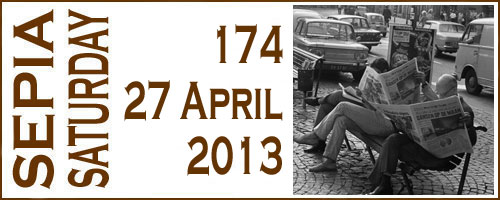About 1940 my uncle Louis was in St. Louis as an intern at Homer G. Philips Hospital. He sent my grandmother in Detroit this telegram on Mother’s Day. These photographs were taken a few years later.
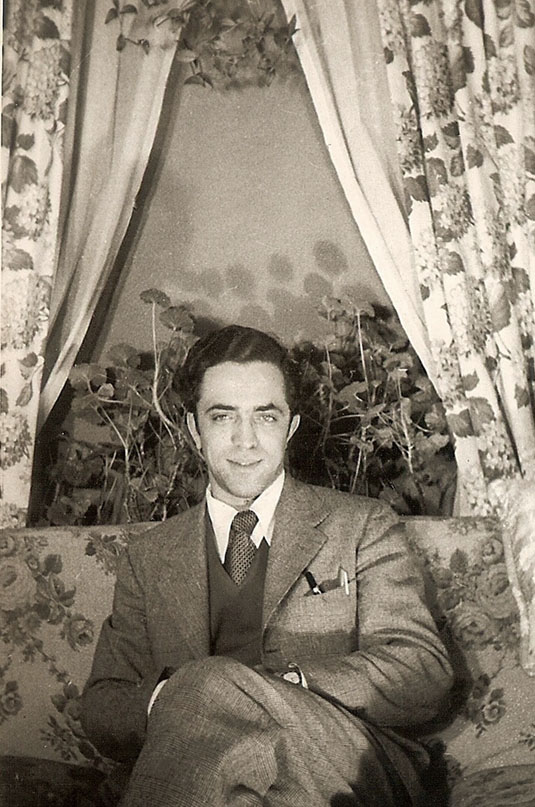
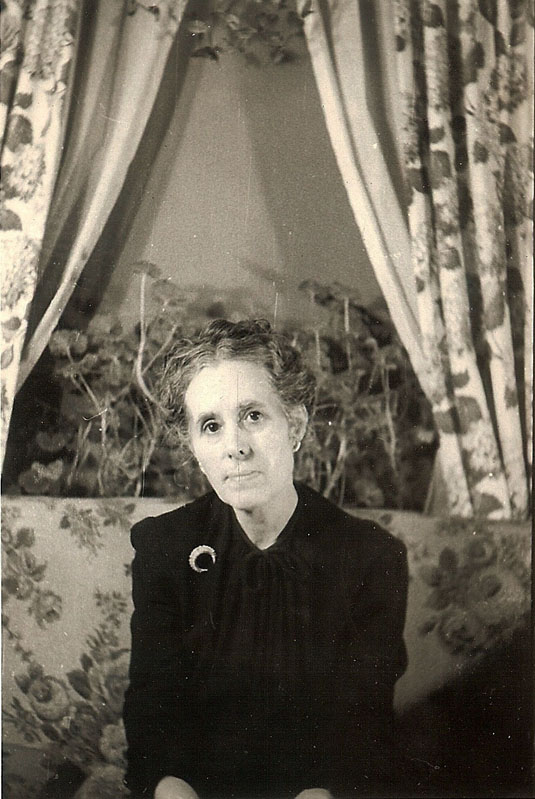

My chemistry career is hazy. I took the required 1 year of classes in high school. I remember the periodic table on the wall, the bunsen burner and the smell of the room. I don’t remember who my teachers were. Maybe it was Mrs. Peterson for the second semester. I know that she was my homeroom teacher for my senior year. We had home room at some point during the day, not at the beginning or the end because we all came to school and finished our day at different times, depending on our schedule.
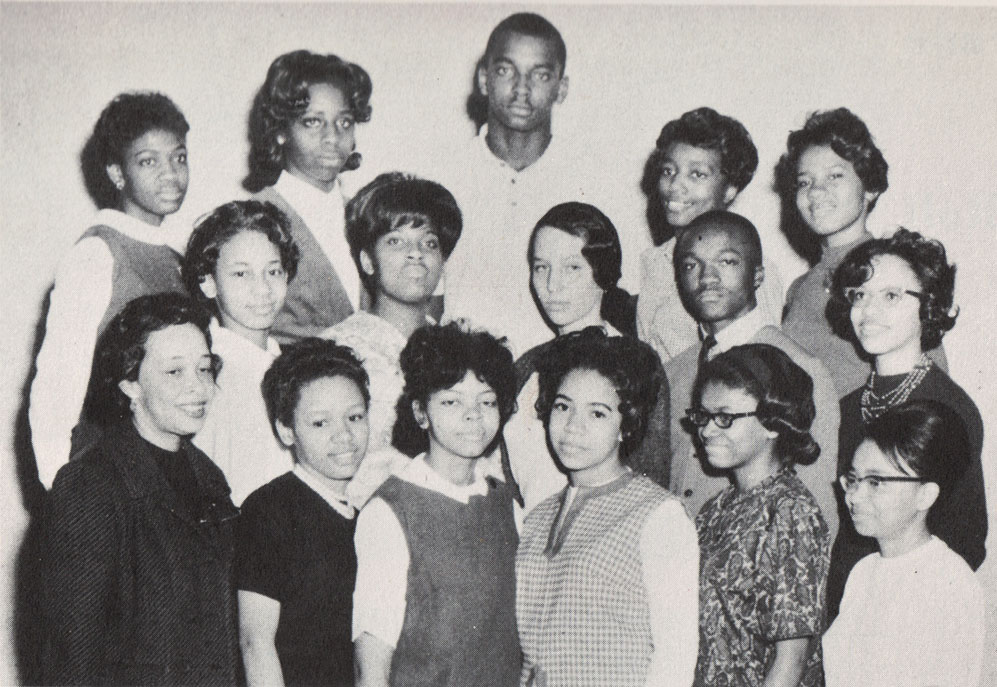
I didn’t like Ms. Peterson. I can’t remember what she looked like. When I try, I see Ms Jones in the photo above. I didn’t like her either. At some point Peterson asked if she could call me “Kirsten” because she liked that better than “Kristin”. I said no, she could not.
Early in my senior year, I decided not to go to my graduation and not to get graduation pictures and therefore not to pay the senior fees. As the year ended, Peterson told me that if I didn’t pay the fees, she was going to put me out of her senior homeroom and I would have to go to the auditorium instead. For reasons I don’t remember, I must have cared because I paid the fee and went to my graduation. That made my Grandmother Cleage happy. It was past time for senior photos by then, but I was in the year book for a few group photos – the one above and another one for the Library staff. I enjoyed my high school career as much as I look like I did in this photo.
I took 1.5 quarters of chemistry in college. At the end of my freshman year, I decided to go into nursing so that I would always be able to find work in the far off places I was going to live in. Chemistry was a television class with a day or two of lab work a week. My experiments never came out right. I worked in a hospital that summer and didn’t feel drawn to the medical field after all. I started off the fall semester taking the second quarter of chemistry but the day of the mid-term, I dropped both chemistry and biology. Such a feeling of relief. I changed to liberal arts and decided to be totally impractically and major in art.

“The air was cool at night. I stretched out my arms in the moonlight and flew. I raced and raced in the cool night expanse, on the largest stage in the world. Around me the mountains ribbed the sky. Under my feet lay the beat of a full symphony orchestra.”
— Agnes De Mille, Dance To The Piper, pg 174
This excerpt below is from a letter written by my father to his parents and siblings in Detroit. You can see my mother hanging up clothes and my father smoking during that same time, up in the header photo.
2130 South Hobart Blvd. #4
Los Angeles, 7, California
September 2, 1944
Hi Folks:
It’s Sunday afternoon…hot as usual…Everything goes along about as usual (the poor get poorer and the rich get richer)…
We went to the Hollywood Bowl last night to see the incomparable “Ballet Theater”…Russian Ballet by S. Hurok. The Bowl is way out in “West h—” from were we live. It took over an hour on the street car to get there… and the last mile took about half of the time… the street-car would move about an inch and wait for ten minutes and then move another inch. We were late…as usual… but in plenty of time to see all we cared to see. The Bowl is a dished out place down in between some mountains…with thousands of seats rising up the mountain sides in front of the stage. The place was jammed! We had the cheapest seats, naturally, which Doris purchased through the Red Cross for a slight reduction…but by climbing over the backs of the seats…very undignified…we managed to sneak into the next higher priced section..where we could see the performers… after a fashion…the section where we belonged …ran on and on…up the mountain…and the people on the stage must have looked like little ants or something…which was just as well…considering the nature of the performance. The dancing was about what you would expect Pee Wee, Gladys and Barbara to put on after a week-end of rehearsal out in the barn. Romeo and J. went on and on for hours…The people sitting next to us…who apparently had never heard of Shakespeare…decided the dance must be about an Egyptian princess or something. “Fancy Free” which was supposed to be terrific…dragged on and on and on…long after the dance was finished. All in all it was quite an evening. We left before the last extravaganza in order to catch a street car before the mob…ran a block and a half…and finally caught what they humorously call street cars out here..and made our way home…

Several weeks ago I read a post on Sheryl’s blog A Hundred Years Ago, about a school play put on in 1913 in which her Grandmother acted the part of Chloe, the maid, in black face. It wasn’t a minstrel show, but there was some discussion about what was accepted in those days and what is accepted now. I googled “minstrel shows” and found photos and articles which show minstrel shows occurring as late as the 1960s in the US. I didn’t realize how many schools, scouts and civic groups put on ministrel shows and plays using black face.
Later, I was looking through my father’s letters home to Detroit while he was a minister in Springfield, MA and I saw the article below about a church that was going to put on a minstrel show in 1947 in Springfield . The NAACP was trying to convince them that this was a bad idea that perpetuated stereotypes about black people that were not true. My father wrote the article below which appeared in the newspaper, The Springfield Republican.
The first link below goes to a page about blackface and racism, in the past and in the present, with links. The other pages are articles and pictures of minstrel shows from 1901 to 1967. I was surprised that there was a television show in Britain called “The Black and White Minstrel Show” that broadcast until 1978.
And a discussion of racism and stereotypes in comics

This was my first A-Z Challenge. My main purpose when I started was to make myself write more. It worked. Before April 1, I filled in the calendar with a topic for each day. After the first week, I realized that I couldn’t do 26 days of posts that required so much research. I was spending all day, and into the night working. By the end, I had simplified my expectations and even got a few posts ahead. I used my usual theme of family history, past, present and future for the A-Z Challenge.
Although it was somewhat daunting to find blogs that spoke to me in the list of over 1,800 participants, I finally got the hang of it and found it easier to look at blogs of people who made interesting comments on blogs I read or people who posted near me on twitter or fb. I would appreciate having more labels. My blog went unlabeled because none of them seemed to fit. I found some new blogs I will be following and made some new blogging friends.
I don’t have a “like” button or a counter, so I have no idea how many people visited unless they left comments. I will probably add both soon. Thanks to Arlee for thinking up this challenge and all the helpers and participants. I look forward to participating in the A-Z Challenge in 2014. Maybe I’ll even get a few posts written in advance during the coming year.
Here are my links for this year’s challenge.
D is for Doctors, Dentists, Nurses and Pharmacists
F is for My Fiercely Creative Family
L is for Long Ago – House War Workers March – 1942 Detroit
M is for the Music of Hubert Averette
N is for a Nostalgic Interview With Henry Cleage
Q is for Questions, Questions and More Questions

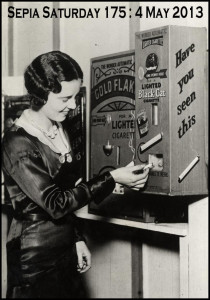
I always liked this photograph of my mother in 1952, holding her cigarette and making a point. She looks so sure of what she’s saying. I assume my father took the photo. It was taken in the living room of the parsonage at 2212 Atkinson, while my father was Pastor of St. Mark’s United Presbyterian Church on 12th and Atkinson. Through the door you can see the kitchen. I remember the tank of guppies, always needing to be cleaned, that stood on a counter under the window. There is the long legged television with Picasso’s “Two Clowns” in the antenna, a leatherette double frame with spaces for pictures and wires attached. When the TV stopped working Mr. Rice, the repairman, came with his big metal toolbox, full of tubes and testers to find the burned out tube and change it. I can’t remember when we no longer needed tubes changed or when we got our next television or what it looked like or when my mother stopped smoking.
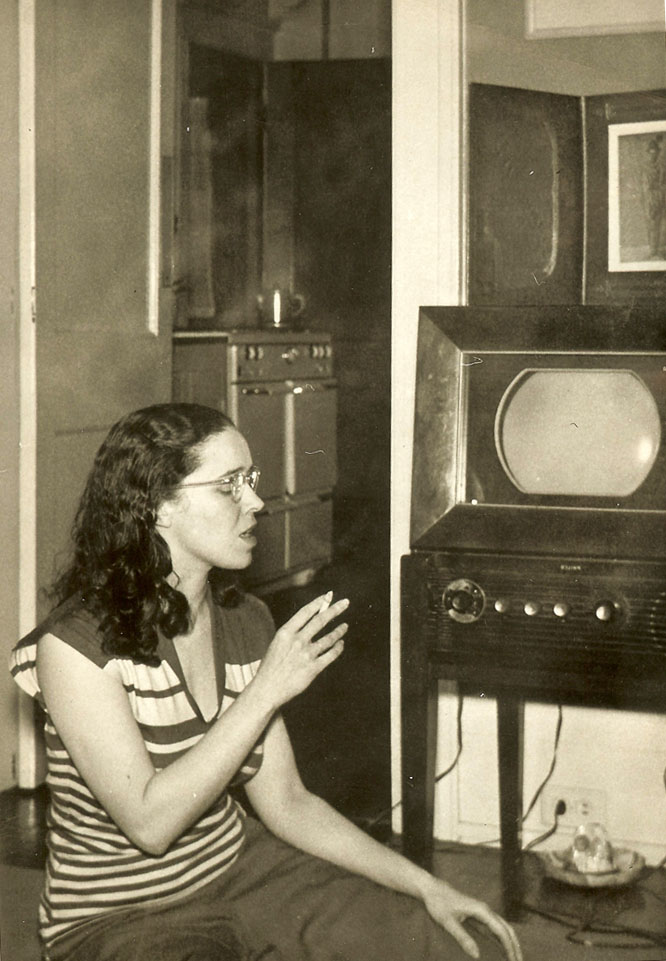
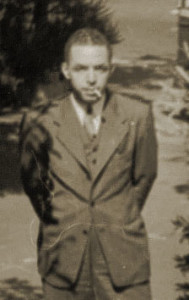
From a letter my father wrote home to Detroit from Los Angeles, CA. on December 4, 1944. Photo by my mother.
“Has the Cigarette shortage hit the hinterland as yet? Here we can’t get any most of the time. I manage to get three or four packages a week with the frantic cooperation of Doris and a boy at school who works where he can get hold of some occasionally. At school the Student-Union sells them every once in a while. Then we all line up for blocks until the seventy-five or one hundred packages are gone. Profound commentary on modern life if anyone has the time to figure out just what is is. Drug stores and Groceries just laugh at you when you ask for Cigarettes…”HA HA HA… Listen Folks, he wants cigarettes…HA HA.”
To want to read more about Cigarettes and where they went during WW2, follow this link Smoke ‘Em if You Got ‘Em.
And here is the recording of Sarah Vaughn singing “No Smoke Blues”. Thank you John J. for mentioning this.

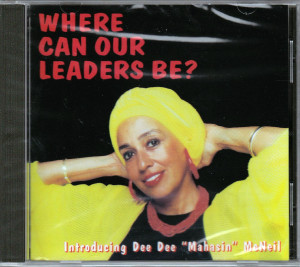 Today I’m going to share the recording, Where Can Our Leaders Be? by my talented cousin, Dee Dee McNeil. Dee Dee started writing as a child. I remember many holidays spent up in Poppy’s room practicing her plays with my sister and cousins. After dinner we would perform for our parents and grandparents. I don’t know if we sang her songs for “our public” but I do remember a few of them, especially “Ho, ho, the little bear skating”, which I can still sing.
Today I’m going to share the recording, Where Can Our Leaders Be? by my talented cousin, Dee Dee McNeil. Dee Dee started writing as a child. I remember many holidays spent up in Poppy’s room practicing her plays with my sister and cousins. After dinner we would perform for our parents and grandparents. I don’t know if we sang her songs for “our public” but I do remember a few of them, especially “Ho, ho, the little bear skating”, which I can still sing.
In 1970 Dee Dee left Detroit and moved to Los Angeles to seek her fortune. She connected with the Watts Prophets soon after and became part of their group, appearing on their album, “Rappin Black in a White World” and sang “What Is A Man” on that album. She also penned and sang the title song of the album “Black In A White World” co-written with fellow Detroiter, Marthea Hicks. Hicks would later die in the Jim Jones Guyanna massacre along with her son, nephew and younger sister. Dee Dee improvised the entire musical score on the original album, playing piano and performing “live” without overdubs. She also recorded several original poems along with the other three male poets who completed the group. She has written songs for several iconic Motown artists including Gladys Knight, Diana Ross, The Four Tops (who originally recorded “What Is A Man”), Edwin Starr, Nancy Wilson, David Ruffin, Rita Marley and many more. I don’t quite get what the visual is about on this YouTube version of “What Is A Man” , but the singing is wonderful.
I found this short, professional biography on Dee Dee’s website. The website also has links to a radio interview, song writing credits, poetry, songs and much much more.
Dee Dee McNeil and Dwight Dickerson Quartet Perform at AUS
Students, faculty and members of the public enjoyed a captivating performance by Dee Dee McNeil and Dwight Dickerson Quartet held at American University of Sharjah (AUS) yesterday, February 17th 2010. A multi-talented vocalist, singer, songwriter, poet, journalist, producer, playwright and educator, Dee Dee McNeil has won renown for her art all over the world. As a contract songwriter for Motown Records in her native Detroit, Michigan, many legendary artists have recorded her music including: Diana Ross and The Supremes, Gladys Knight and The Pips, David Ruffin, Edwin Star, The Four Tops, Nancy Wilson, Rita Marley, Kiki Dee, Jonah Jones, Side Effect, and the rapper ‘Styles.’ She was a contributing member of the historic rap group, The Watts Prophets, now recognized as one of the major forerunners of contemporary hip hop music. She was one of the first women to rap in the late ’60s and early 70’s, speaking up as an articulate champion for women’s rights. One of her raps about respect for women was used as the televised theme song during New Zealand’s Miss Universe Contest in 1983. The plays she has written are based on historic figures and their musical contributions.
Where Can Our Leaders Be?

Today is my 26th and final post for the April A-Z Challenge. I am going to post a bit about my brother-in-law, Zaron Burnett aka Zeke. He was a conscious objector during the War in Vietnam, executive aide to the chairman of the Fulton County Commission and lived in a car while writing his novel, The Carthaginian Honor Society. He is a performance artist and the creator of Club Zebra, a performance installation which he describes as “a floating speakeasy and cabaret and the international center of bohemian negritude”. He is an analytical thinker who was dubbed “the merciless” by my uncle Henry, who said upon meeting zeke: “He’s handsome, in a merciless sort of way.” He is co-author, with his wife, Pearl Cleage, of the poem “We Speak Your Names,” commissioned by Oprah Winfrey for her Legends Weekend in 2005. He’s a golfer, a handy man, a protector of those who need protection and he grows the most delicious tomatoes and peppers. Without further ado I give you, ZEKE!

This is my 25th post for the April A-Z Challenge. Today I have a photo of my Uncle Louis Cleage’s yacht. He seems to be appearing a lot, here at the end of the alphabet. Somewhere in my collection, I remembered a comment of my father’s, something like, “Louis joined the capitalist class” when he got the yacht. I thought it was in the collection of letters he wrote home but after reading through them several times without finding it, I think it might have been in the old, crumpling, photo album. I can’t find that either, but either way, that puts the purchase of the yacht during the late 1940s, after the end of WW2. I was only on the boat once and I got sea sick. I also got train sick and bus sick.
Louis must have sold the boat in the early 1950s because I don’t remember it later. My uncles used to talk about going over to Walpole Island, unceeded territory at the mouth of the St. Clair River, and sitting around talking with the First Nation People. There was mention of campfires and my Uncle Hugh almost staying or being left. I remember a boy in my 6th grade art class who was from Walpole Island. His name was Frank Shipman and he opened a jar of glue for me when no one else could get the top off. Later he moved to Wabash street. I didn’t think it compared with an island between two rivers.

This photo comes from my Cleage stash and features Alice, my Uncle Henry’s first wife, reading a Thrilling Comic. How did she happened to be reading it? Did she enjoy comics? Love thrillers? Was she posing (or posed) for the photo? Was the comic book laying around because that is where Henry got his short story ideas? Judging by her eyes, she does look mildly thrilled.
“Thrilling Comics was one of the longest runs the publisher had. It ran for eighty issues. The issues themselves featured many different kinds of comic stories like the standard superhero story as well as westerns, detective, stories, comedies, comic strips, short stories and many more.” The series started in 1940 and ran through 1951. To see all the covers for the 80 issues, click Thrilling Comics.
